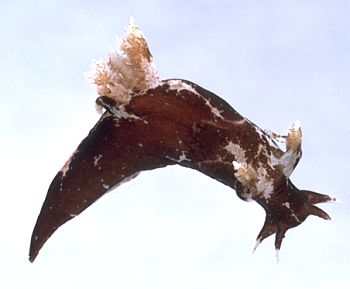
Trapania brunnea
Rudman, 1987
Order: NUDIBRANCHIA
Suborder: DORIDINA
Family: Goniodorididae
DISTRIBUTION
Southeastern Australia from New South Wales, Lord Howe Island, Victoria, Tasmania, South Australia. Also known from northern New Zealand.
PHOTO
Upper & Lower Right: Lower right photo showing uniform nature of background coloration of the mantle. Flinders, Westernport Bay, Victoria, March 1986.
Lower Left: Clovelly, Sydney, New South Wales, October 1978.
PHOTOS: Bill Rudman.
The body is dark brown with sparsely scattered irregular white spots. There are a number of symmetrically arranged white patches and streaks as seen in the photographs. Both the anterior and posterior lateral processes are dark brown except for a basal region, and the tip, which are both translucent clear with white patches. It grows to 18mm long alive. The dark brown body with white patches is quite distinctive. It is somewhat similar in colour to Trapania benni but in that species the background colour is a paler reddish brown with a close covering of yellow or white specks. There are also larger yellow spots in the white patches. They differ considerably in tooth morphology.
Reference:
• Rudman,W.B.(1987). The genus Trapania (Nudibranchia: Goniodorididae) in the Indo-West Pacific. Journal of Molluscan Studies, 53: 189-212.
• Willan, R.C. (1989) First record of the nudibranch Trapania brunnea Rudman in New Zealand waters with comments on intraspecific variation in the species. The Veliger, 32(2): 182-184.
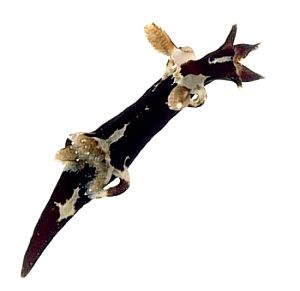
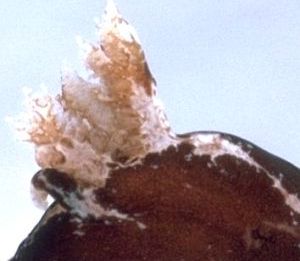
Rudman, W.B., 2001 (April 4) Trapania brunnea Rudman, 1987. [In] Sea Slug Forum. Australian Museum, Sydney. Available from http://www.seaslugforum.net/find/trapbrun
Related messages
Trapania brunnea from sthn Queensland
October 26, 2009
From: Gary Cobb
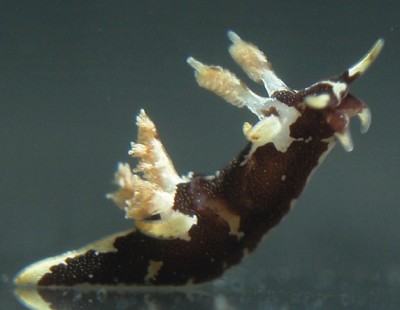

Concerning message #22714:
Hi Bill and everyone!
After reading the message from the Atkinsons I thought I would send you a report on Trapania brunnea from my neck of the woods.
Locality: Off Mooloolaba, Sunshine Coast, 18 m, Queensland, Australia, Pacific Ocean, 08 April 2006, Subtidal. Length: 7 mm. Photographer: Gary Cobb.
On this dive we found two animals on the same sponge.
Cheers
Gary
gary@nudibranch.com.au
Cobb, G., 2009 (Oct 26) Trapania brunnea from sthn Queensland. [Message in] Sea Slug Forum. Australian Museum, Sydney. Available from http://www.seaslugforum.net/find/22716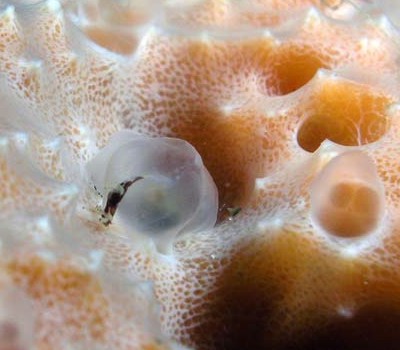
Thanks Gary,
Best wishes,
Bill Rudman
Re: Trapania brunnea from Bare Island, Sydney N.S.W
October 22, 2009
From: Leanne and David Atkinson

Concerning message #22687:
Dear Bill,
Re: message by Nick Missendon on Trapania brunnea. We have seen this nudibranch frequently at Port Stephens as well, mostly at the dive sites Fly Point and Halifax Sponge Gardens. We usually find it on an orange sponge that is locally called Dead Man's Fingers but we don't know the scientific name. We've sent a photo of diver and the sponge as well as some shots of the Trapania brunnea. In each of the Trapania brunnea shots we can see some kamptozoa. These nudibranchs seem to vary a bit in the shade of brown but as you noted they always have the small colourless spots.
Upper Photo: 'Deadman's Fingers' & Leanne Atkinson. Halifax Sponge Gardens, Port Stephens-Great Lakes Marine Park, Port Stephens, New South Wales, Australia. Depth: 15 metres. Sponge Height approximately 300 mm. 03 January 2009. General locality information: Rocky and sandy bottom with scattered sponges, ascidians, bryozoans, gorgoniams and soft corals. Photographer: David Atkinson.
Middle Photos: Trapania brunnea on sponge covered with kamptozoa. Close-up shows individual kamptozoan zooids with stomach contents showing as brown spots. Halifax Sponge Gardens, Port Stephens-Great Lakes Marine Park, Port Stephens, New South Wales, Australia. 15 metres. Specimen length: 10 mm. 08 April 2007. Photo: Leanne & David Atkinson.
Lower Photo: Showing kamptozoa & pair of Trapania brunnea. Fly Point, Port Stephens-Great Lakes Marine Park, Port Stephens, New South Wales, Australia. 15 metres. Specimen length: approximately 8 mm. 23 August 2009. Photo: Leanne & David Atkinson
Hope this is of interest.
Regards,
Leanne & David Atkinson
atk@hunterlink.net.au
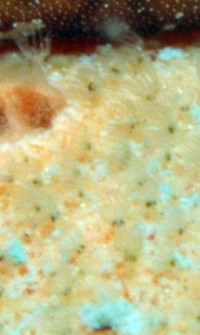
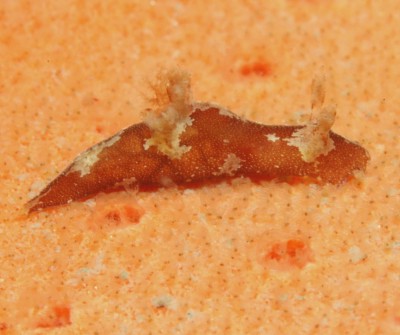

Dear Leanne and David,
Thanks for these photos, which show the kamptozoa and their brown spots so well. The brown spots are their stomach contents. In the close-up I have altered the colour balance so the zooids can be seen more clearly. The sponge is different from that in Nick's message which also illustrates that the attraction of Trapania to sponges is because of the presence of the kamptozoa rather then any particular liking for sponges. The common name "dead man's fingers" is quite an expressive common name which is used around the world for quite a lot of different finger sponges and also soft corals. Sorry I can't give you a scientific name.
Best wishes,
Bill Rudman
Re: Trapania brunnea from Bare Island, Sydney N.S.W
October 19, 2009
From: Nick Missenden

Concerning message #14738:
Hi Bill,
I was working on my website and in particular writing a page on Trapania brunnea and where to find them for our local divers and wondered if you knew the name of the white sponge on which we find them here at Bare Island, Sydney. Also I noticed when scanning the other messages on this species that all the other pictures show that the nudibranch is very dark and the rhinophores were either partially or fully coloured. In comparison the Trapania I have sent in to you for identification and all the others I have seen at Bare Island are pale in colour and have no colouration on their rhinophores. Is this a normal variation for this species?
Locality: Bare Island, La Perouse, 16 m, NSW, Australia, Botany Bay, 2 October 2005, Broken reef, sandy bottom. Length: 10 mm. Photographer: Nick Missenden.
Kindest Regards,
Nick
njmpm@iinet.net.au
Missenden, N.J., 2009 (Oct 19) Re: Trapania brunnea from Bare Island, Sydney N.S.W. [Message in] Sea Slug Forum. Australian Museum, Sydney. Available from http://www.seaslugforum.net/find/22687
Dear Nick,
Specimens from New South Wales seem to be a bit paler in colour, but you will note that even the dark brown ones have the small colourless spots all over the the brown patches.
I am pretty sure the sponge is Holopsamma laminaefavosa, but I am not an expert in sponges so you would need get it checked. This is the name used by Graham Edgar in Australian Marine Life: the plants and animals of temperate waters. (2000) Reed New Holland: Sydney. As the author made every effort to check his identifications, I am fairly confident it will be correct.
As I have said quite often, species of Trapania are often found on various sponges and were previously thought to eat them, but we now know they actually eat small stalked animals called kamptozoa which live on sponges
Best wishes,
Bill Rudman
Radular morphology of Trapania brunnea [2]
March 12, 2008
From: Bill Rudman
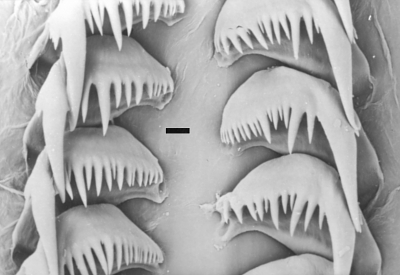
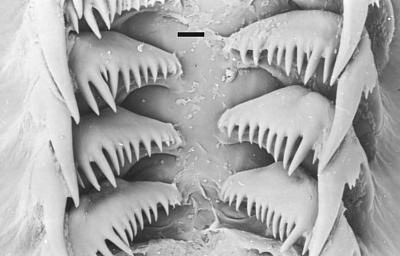
To complement today's posting of many new species of Trapania here are some SEM photos showing aspects of the morphology of the radula of another specimen of Trapania brunnea.
SEM photos showing sections of the radular ribbon. Flinders Pier, Westernport Bay, Victoria, Australia. 17 mm long alive. March 1986. AM C149527. SEM Photos: G. Avern. Scale = 10 µm.
- Rudman, W.B. (1987) The genus Trapania (Nudibranchia: Goniodorididae) in the Indo-West Pacific. Journal of Molluscan Studies, 53: 189-212.
Best wishes
Bill Rudman
Radular morphology of Trapania brunnea [1]
March 12, 2008
From: Bill Rudman
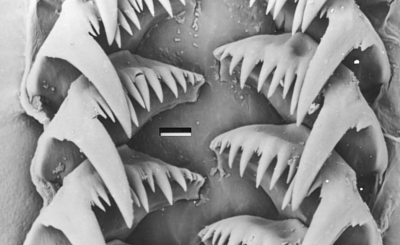

To complement today's posting of many new species of Trapania here are some SEM photos showing aspects of the morphology of the radula of Trapania brunnea from Sydney, NSW.
SEM photos showing sections of the radular ribbon. Clovelly, Sydney, NSW, Australia, 10-5 m, October 1978, AM C111939, Paratype. SEM Photos: G. Avern. Scale = 10 µm.
- Rudman, W.B. (1987) The genus Trapania (Nudibranchia: Goniodorididae) in the Indo-West Pacific. Journal of Molluscan Studies, 53: 189-212.
Best wishes
Bill Rudman
Re: Trapania brunnea from Bare Island, Sydney
September 15, 2005
From: Nicholas Missenden
Thankyou for the id [message #14738 ]:
I didn't know that was the common name for this nudi. I used a resource book to id it and hence that's where I got the name from. Thanks again for giving me the correct name.
Regards
Nick
njmpm@iinet.net.au
Missenden, N.J., 2005 (Sep 15) Re: Trapania brunnea from Bare Island, Sydney. [Message in] Sea Slug Forum. Australian Museum, Sydney. Available from http://www.seaslugforum.net/find/14774Dear Nick,
I hope you didn't think I was criticising you. Clearly you have been a victim of an author or editor 'dumbing down' their publication. I have fairly strong views on the use of common names, because they are so confusing and are seldom 'common' in the sense of 'commonly used'. They are usually made up by authors on the insistence of editors on the mistaken assumption that readers are too dumb to use scientific names. One of the reasons scientific names were invented was to provide a universal name for each species which would be understood in all languages. Trapania brunnea applies to only one species, but Brown Trapania could mean 3 or 4 species at least. The best example of the confusion common names create are the names for fish in Australia and New Zealand where one species can have 5 or 6 different common names and so fisherman from NSW and Western Australia can't effectively communicate. I don't believe divers and naturalists are too dumb to use scientific names, despite the push by editors and authors to brainwash them into thinking they are.
Best wishes,
Bill Rudman
Trapania brunnea from Bare Island, Sydney N.S.W
September 14, 2005
From: Nicholas Missenden
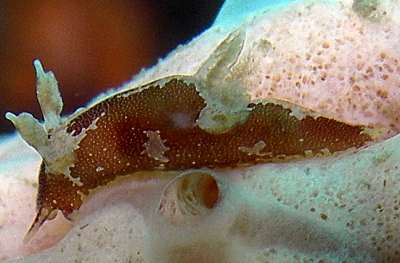
Hello again Bill,
Could you please confirm the identity of this nudi, I believe it is a Brown Trapania.
Locality: Bare Island, West Reef, Botany Bay. Sydney, NSW, Australia.
Depth: 8 m. Length: 8 mm. 09 September, 2005. Broken reef, sandy bottom
Photographer: Nicholas Missenden
Again, thankyou for all your help so far and best wishes.
Regards
Nick Missenden
njmpm@iinet.net.au

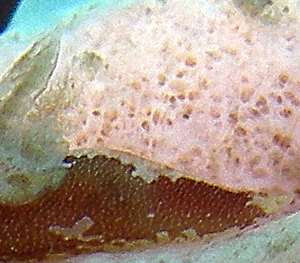
Dear Nick,
This is Trapania brunnea. Apart from a few very special cases, I don't use 'common' names like 'Brown Trapania' on the Forum. As I have discussed many times they are not 'commonly used' so become very confusing. If you look at the 'close-up' of your photo, you can see small brownish spots on the sponge. These are small stalked animals called kamptozoa, which are often found living opn these sponges, and are the food of species of Trapania.
Best wishes,
Bill Rudman
Trapania brunnea from New Zealand
July 13, 2004
From: Ross Armstrong
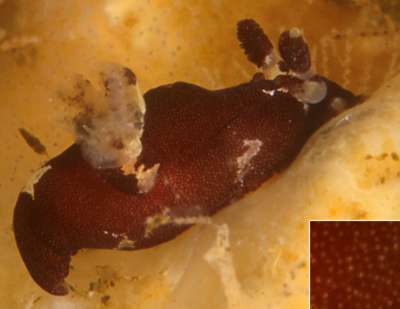
Dear Bill,
I found these two little nudibranchs close together in Taravana Cave at the Poor Knights [NE New Zealand}. They would have only been 3-4mm long at most. I am not sure if the white (assume) dead bryozoan in the picture was because it was feeding on it on not.
cheers
Ross
ross@oceanwildlife.com
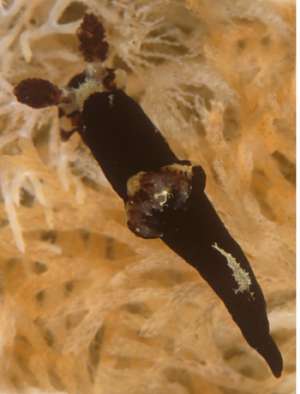
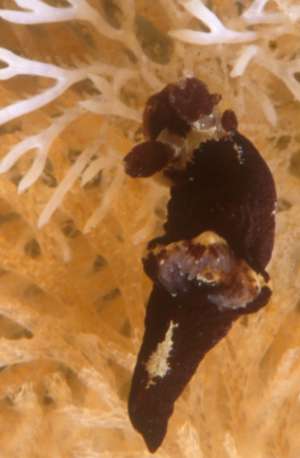
Thanks Ross,
This is Trapania brunnea which has only been reported from New Zealand once before (Willan, 1989) - also from the Poor Knights.
It certainly looks like a species of Polycera, which certainly feed on arborescent bryozoans, but if you look carefully you will see it has two pairs of recurved tentacles - one pair flanking the gills, and the other the rhinophores. Species of Trapania are usually found associated with sponges but if you look at the previous messages on this page we know are pretty certain they feed on small stalked animals called entoprocts which are found attached to sponge colonies and other colonial organisms. Your photos are an interesting addition to our knowledge of this species
Best wishes
Bill Rudman
Trapania brunnea from S.E. Australia (2)
March 4, 2002
From: John Chuk
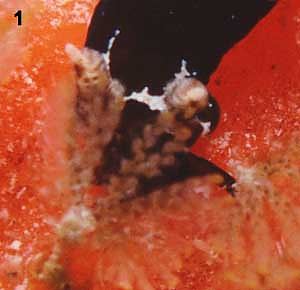
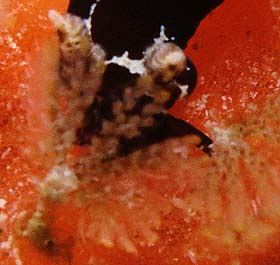
Dear Bill,
Your comments on the specimens of Trapania brunnea that I thought were feeding on a small arborescent bryozoan made me have a close look at the series of slides.
There is something white on the surface of the sponge but I find no evidence to suggest what it may be. The shots were taken using a 1.5:1 extension tube, which should have the magnification and resolution needed to show detail of entoprocts, were they present.
The behaviour I observed on the dive that suggested that the specimens were feeding on the bryozoan is shown in the two images attached. It could be that the specimen merely blundered into the bryozoan, though it did not retreat in a hurry. I suspect that having seen other nudibranchs feeding on this bryozoan, may well have prompted me to conclude that these specimens were also feeding, when they may well have encountered the bryozoans by accident in their progress across the sponge. I suppose the only sure way to determine if an animal is feeding is to remove it and observe if the mouth is everted?
Best wishes,
John.
jchuk@giant.net.au
Chuk, J., 2002 (Mar 4) Trapania brunnea from S.E. Australia (2). [Message in] Sea Slug Forum. Australian Museum, Sydney. Available from http://www.seaslugforum.net/find/6336Dear John,
Thanks for following this up. In your closeup photo we can see that the head of the Trapania is under the bryozoan colony. It could be eating the basal trunk of the colony but I doubt it. My money is on the fuzzy white things. By chance I found Trapania brunnea this week in Mallacoota [on the border between New South Wales and Victoria, Australia] on a very similar bright orange red sponge. With your photos in mind I carefully collected the rock the sponge was attached to and took it back to where I was staying and checked it under a microscope. The whole surface of the sponge was covered in entoprocts. I collected samples of a number of other colonies of the sponge at the same time. They had neither Trapania nor entoprocts. It is difficult to use negatives as proof but I think the evidence is building up in favour of entoprocts being the food of Trapania. Hopefully my photos will come out. If so I will post them on the Forum in a few days.
Concerning your question about checking if an animal is feeding by seeing if its mouth is everted. Unfortunately that only works for some species. Most sponge-feeding dorids evert their foregut to some extent when feeding so if you gently lift them up you will almost inevitably see part of the foregut everted if they are feeding. However some families feed by biting off polyps or small bits of their prey. In these animals there is no eversible foregut so it is more difficult to see direct signs of feeding, although there is often damage to the colony they are feeding on.
Best wishes,
Bill Rudman
Trapania brunnea from S.E. Australia
February 17, 2002
From: John Chuk
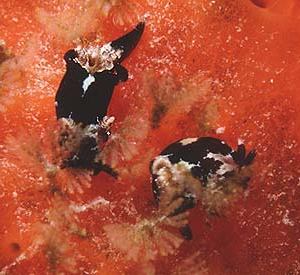
Dear Bill,
Here is an in situ shot of two specimens of Trapania brunnea seen feeding on small arborescent bryozoan colonies that were growing out of an orange sponge. They were found at a depth of 3m on a pier pylon at Portsea pier, Victoria, Australia, on December 18, 2001. The specimens were both 14mm in length.
I am unable to identify the bryozoan but it appears to be a popular food source for several species of nudibranch at this site.
Best wishes,
John.
jchuk@giant.net.au
Chuk, J., 2002 (Feb 17) Trapania brunnea from S.E. Australia. [Message in] Sea Slug Forum. Australian Museum, Sydney. Available from http://www.seaslugforum.net/find/6221Dear John,
Thanks for this photo. If they are feeding on the bryozoans it will be an interesting observation because we have got quite a bit of evidence on the Forum to show they feed on entoprocts rather than bryozoans (which are also called Ectoprocta to confuse the issue]. Entoprocts are a strange group of invertebrates that used to be considered bryozoans. Have a look at my recent message about Trapania toddi. It is possible the fuzzy stuff on the red sponge is a 'carpet' of entoprocts and the bryozoans are just there coincidentally, or it could be that they are feeding on arborescent bryozoans. Either information would be of interest as we have no information on this species' food. Perhaps you could check out your photos from some conclusive evidence one way or the other,
best wishes,
Bill Rudman
